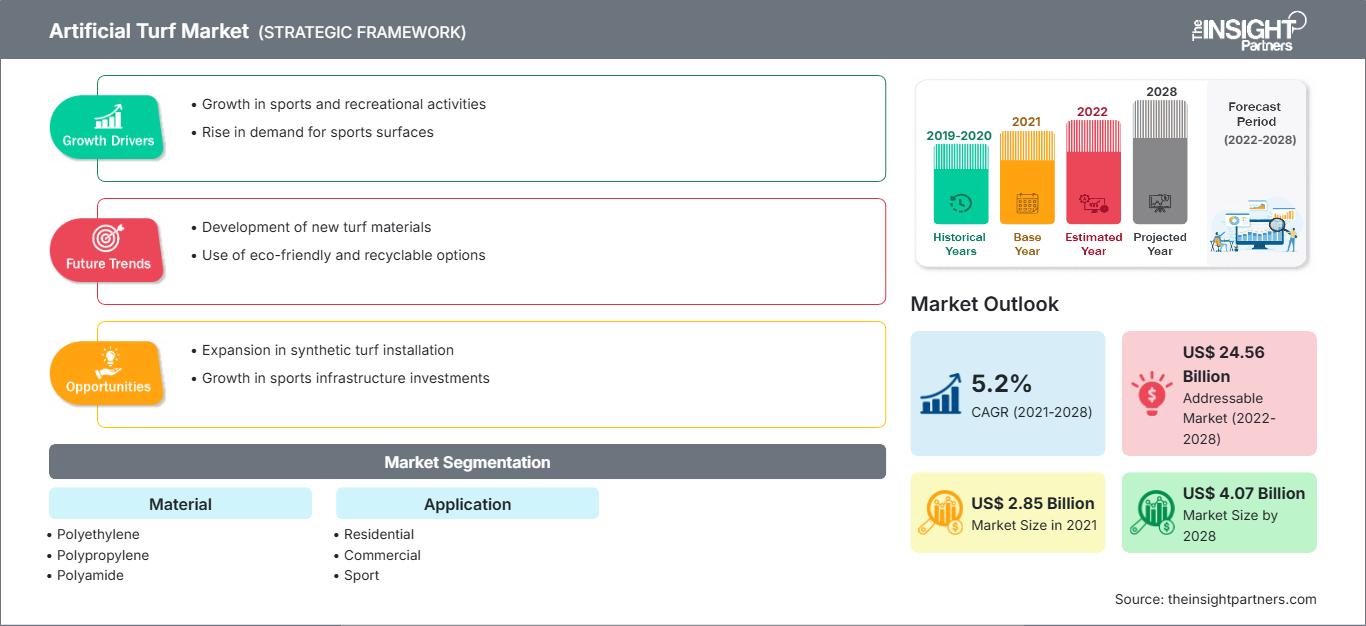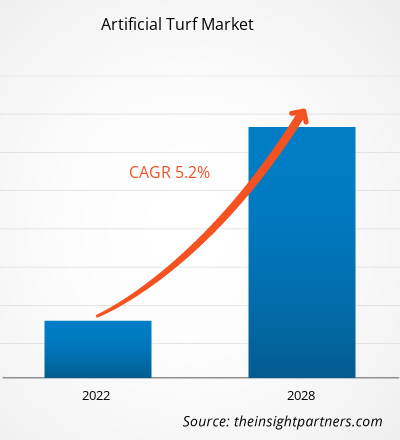Le marché du gazon artificiel était évalué à 2 847,28 millions de dollars américains en 2021 et devrait atteindre 4 067,36 millions de dollars américains d'ici 2028. Il devrait croître à un TCAC de 5,2 % entre 2021 et 2028.
Fabriqué à partir de fibres synthétiques, le gazon artificiel est conçu pour imiter le gazon naturel. Les matières premières utilisées pour sa production comprennent le polyéthylène (PE), le polypropylène (PP), le polyamide (Nylon), des composés de caoutchouc, de la mousse de polyester, différentes couleurs et d'autres additifs. La qualité des matières premières est essentielle à la performance du gazon. Le marché mondial du gazon artificiel est analysé en fonction du matériau, de l'application et de la géographie. En 2020, l'Asie-Pacifique détenait la plus grande part de chiffre d'affaires du marché mondial du gazon artificiel. Le principal facteur de croissance du marché du gazon artificiel en Asie-Pacifique est l'utilisation croissante du gazon artificiel dans le secteur domestique. Les nombreux avantages du gazon synthétique, tels qu'une consommation réduite d'eau et de produits chimiques, un entretien minimal, l'absence d'irrigation et une résistance aux intempéries, contribuent à une forte demande de gazon synthétique pour les installations sportives. De plus, la mondialisation croissante et la croissance du secteur de la construction favorisent également la croissance du marché du gazon synthétique. De plus, les acteurs du marché de cette région ont investi massivement dans la R&D, contribuant au développement de plusieurs produits innovants, contribuant ainsi à la croissance de ce marché régional.
Vous bénéficierez d’une personnalisation sur n’importe quel rapport - gratuitement - y compris des parties de ce rapport, ou une analyse au niveau du pays, un pack de données Excel, ainsi que de profiter d’offres exceptionnelles et de réductions pour les start-ups et les universités
Marché du gazon artificiel: Perspectives stratégiques

-
Obtenez les principales tendances clés du marché de ce rapport.Cet échantillon GRATUIT comprendra une analyse de données, allant des tendances du marché aux estimations et prévisions.
Impact de la pandémie de COVID-19 sur le marché du gazon artificiel
La pandémie de COVID-19 a posé des défis sans précédent à de nombreux secteurs, notamment celui des produits chimiques et des matériaux. En raison du confinement national et des restrictions aux frontières, les chaînes d'approvisionnement ont été complètement perturbées. Cela a affecté la production et la distribution de divers produits. De nombreuses zones de loisirs et aires de jeux ont été fermées en raison du virus, ce qui a provoqué une augmentation des rénovations résidentielles dans le monde entier. Selon Synthetic Grass Warehouse, les entrepreneurs en gazon artificiel enregistrent des gains de ventes allant jusqu'à 30 % par rapport à 2020. Les applications sur terrains de sport ont représenté 63 % du gazon installé en 2020 et devraient rester le plus grand domaine d'application au cours de la période de prévision. Cependant, le gazon dans les applications paysagères connaît une croissance rapide. Dans un avenir proche, les plateformes de commerce électronique devraient connaître un essor significatif dans la vente de divers produits essentiels et non essentiels, notamment le gazon synthétique.
Aperçu du marché
Demande croissante de gazon synthétique dans l'industrie du sport et nombre croissant de stades
Le gazon synthétique convient à divers sports, mais il est couramment utilisé pour le baseball, le football américain, la crosse, le rugby et le soccer. En 2021, le Bank of America Stadium a décidé de passer du gazon naturel au gazon synthétique. Tepper Sports & Entertainment a annoncé qu'il abandonnerait le gazon synthétique au profit du FieldTurf avant la saison 2021 des Carolina Panthers. Le BC Place Stadium disposera également d'un nouveau terrain en gazon synthétique au Canada d'ici fin janvier 2022. De plus, des terrains en gazon synthétique ont fait leur apparition dans les villes et les villages de pays comme l'Inde. Par conséquent, la demande croissante de gazon synthétique dans l'industrie du sport et le nombre croissant de stades utilisant du gazon synthétique stimulent considérablement le marché mondial du gazon synthétique.
Aperçu des applications
En fonction de l'application, le marché mondial du gazon synthétique a été segmenté en résidentiel, commercial et sportif. Le segment sportif détenait la plus grande part du marché mondial du gazon synthétique en 2020. Le gazon synthétique est largement utilisé sur les terrains de sport. Il est principalement utilisé pour fournir une surface adéquate pour les sports pratiqués sur gazon dans les zones où l'entretien du gazon naturel est difficile ou ne peut pas pousser. La forte demande de gazon synthétique de l'industrie du sport est principalement due à divers facteurs tels que la facilité d'entretien, un temps de jeu plus long, etc.
Parmi les principaux acteurs du marché mondial du gazon synthétique, on trouve The Dow Chemical Company ; Tarkett ; Act Global ; CCGrass ; TenCate Grass ; SIS Pitches ; Victoria PLC ; GreenFields BV ; HATKO ; et Hellas Construction, Inc. Ces acteurs se concentrent principalement sur plusieurs stratégies, telles que le lancement de nouveaux produits, l'expansion et les fusions et acquisitions, pour leur expansion.
Gazon artificiel
Aperçu régional du marché du gazon artificiel
Les tendances régionales et les facteurs influençant le marché du gazon synthétique tout au long de la période de prévision ont été analysés en détail par les analystes de The Insight Partners. Cette section aborde également les segments et la géographie du marché du gazon synthétique en Amérique du Nord, en Europe, en Asie-Pacifique, au Moyen-Orient et en Afrique, ainsi qu'en Amérique du Sud et en Amérique centrale.
Portée du rapport sur le marché du gazon artificiel
| Attribut de rapport | Détails |
|---|---|
| Taille du marché en 2021 | US$ 2.85 Billion |
| Taille du marché par 2028 | US$ 4.07 Billion |
| TCAC mondial (2021 - 2028) | 5.2% |
| Données historiques | 2019-2020 |
| Période de prévision | 2022-2028 |
| Segments couverts |
By Matériau
|
| Régions et pays couverts |
Amérique du Nord
|
| Leaders du marché et profils d'entreprises clés |
|
Densité des acteurs du marché du gazon synthétique : comprendre son impact sur la dynamique commerciale
Le marché du gazon synthétique connaît une croissance rapide, portée par une demande croissante des utilisateurs finaux, due à des facteurs tels que l'évolution des préférences des consommateurs, les avancées technologiques et une meilleure connaissance des avantages du produit. Face à cette demande croissante, les entreprises élargissent leur offre, innovent pour répondre aux besoins des consommateurs et capitalisent sur les nouvelles tendances, ce qui alimente la croissance du marché.

- Obtenez le Marché du gazon artificiel Aperçu des principaux acteurs clés
- Analyse historique (2 ans), année de base, prévision (7 ans) avec TCAC
- Analyse PEST et SWOT
- Taille du marché Valeur / Volume - Mondial, Régional, Pays
- Industrie et paysage concurrentiel
- Ensemble de données Excel
Rapports récents
Témoignages
Raison d'acheter
- Prise de décision éclairée
- Compréhension de la dynamique du marché
- Analyse concurrentielle
- Connaissances clients
- Prévisions de marché
- Atténuation des risques
- Planification stratégique
- Justification des investissements
- Identification des marchés émergents
- Amélioration des stratégies marketing
- Amélioration de l'efficacité opérationnelle
- Alignement sur les tendances réglementaires






















 Obtenez un échantillon gratuit pour - Marché du gazon artificiel
Obtenez un échantillon gratuit pour - Marché du gazon artificiel